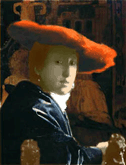|
|
|
Application of Local Color , Wet in Wet
 overpainting with local colour |
Once the general aspect of
the painting had been defined in the underpainting, Vermeer began applying local color.
Local color is simply the color, or colors, of a particular object. He employed fine sable
brushes and used no more than nine
or ten different pigments. He avoided glazes,
fine detail, and highlights at this stage of the painting. Some areas, like the hat,
were painted very opaquely while others, like the girl's robe, were painted very thinly in
order to create different optical effects. He modeled the plumed hat with vermilion and small amounts of ivory black in the shadows and used a badger brush to blend darks and lights and smooth the brush strokes. It would be glazed later. Natural lapis lazuli and lead white were used to paint the robe where the warm underpainting can be seen through brushwork. This creates a very luminous effect in the robe's shadows. The carpet, hanging in the background, was painted in various shades of lapis lazuli and earth colors. Adjacent areas of different colors were blended while they were still wet, hence the term "wet in wet". During this stage Vermeer spent longs hours gradually harmonizing color and perfecting modeling. The light parts of the face were painted with lead white, yellow ochre, and vermilion. He used green earth in the shadowed areas. The use of green earth was very common among Italian painters of the early Renaissance but was replaced by raw umber because it has a more natural warm tone. Some of the most beautiful examples of umber in flesh tone shadows can be found in Rembrandt's portraits. We do not know why Vermeer employed this archaic technique but he did use it in many of his later paintings such as the "Girl with a Flute," the "Woman Standing in front of a Spinet," and the "Allegory of Faith." 1 2 3 4 5 |